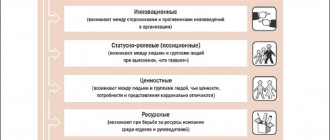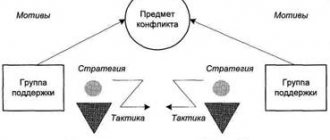The end of a conflict means any end or cessation of it. It can be the result of both mutual reconciliation of the parties, the achievement of a certain agreement between them, and the gradual fading of the confrontation or its escalation into another conflict. The main prerequisite for ending the conflict is the elimination of objective and weakening of the subjective causes that gave rise to the conflict situation.
Conflicts significantly affect the entire production and management process in an organization. Henry Ford famously said: “If you learned how to resolve conflicts, it would reduce the cost of a car more than 25 years of technical innovations.”
However, the conflict cannot always be resolved. Moreover, many conflicts do not need resolution, but competent management, since they can bring benefits.
Method of avoiding conflict
This is the most popular control method.
Its essence: the parties seek to avoid conflict by “leaving the scene” economically, physically or psychologically. The decision to use the method is made very quickly. The method is used when conflict is not needed, it does not fit the situation in the organization, or if the costs of a possible conflict would be very high. Other reasons for using this method include:
- the triviality of the problem underlying the conflict;
- pressure from more important circumstances;
- “cooling” of flared passions;
- collecting additional information and avoiding making an immediate decision;
- a situation where the subject of the conflict only indirectly affects the essence of the problem or points to other, deeper reasons;
- fear of the other side;
- unlucky timing of impending conflict.
Typical behavior when using this method is:
- the existence of a problem at all is denied in the hope that it will disappear by itself;
- the solution to the problem is delayed;
- prolonged procedures are used to suppress conflict;
- refer to existing bureaucratic and legal norms as the basis for resolving the conflict.
The method is not applicable in the following cases:
- the importance of the problem;
- the prospect of a long-term existence of the foundations of this conflict, since the method is effective only in fleeting conflicts;
- when loss of time in the long term leads to loss of initiative and high costs.
It is believed that the result of the conflict when using this method fits into the “win-loss” scheme.
A variation of the method of “avoiding conflict” is the method of inaction.
Its essence: do not perform any actions at all. This method is justified in conditions of complete uncertainty, when it is impossible to calculate options for the development of events. The consequences of using this method are predictable and can be beneficial for the conflictant.
Bypass or avoidance ↑
Bypassing open conflicts is advisable to use in situations where successfully overcoming a conflict is impossible.
For example, if it is necessary to change an objective conflict situation - to improve the structure of a certain institution or organization, to redistribute job responsibilities, material or labor resources, when there is no possibility for this.
When implementing bypass technology, the tactics for overcoming the conflict involve specific measures and means:
- isolation, “separation” and setting boundaries for the parties - when the participants in the confrontation (one or more) are actually fenced off, they no longer have the need for communicative contact (for example, transferring one of the employees to another structural unit);
- limitation of opportunities - when one or more participants in the discord are reduced in the power that is necessary to achieve their own goals (for example, when the head of a structural unit is transferred to a lower position due to abuse of official position);
- introduction of censures (fines and sanctions of various kinds) - when, as a result of the imposition of administrative penalties, real or probable, the parties are forced to break off a quarrel (for example, in the event of a conflict between two officials, they may be positively influenced by the warnings of the head of an institution or organization to reprimand both for tactless and uncivil behavior);
- change in energy flows - when the energy of participants in disagreements is radically redirected in a different direction, for example, to accomplish common tasks or to defeat external “opponents” (you can instruct the parties to the confrontation to prepare a reasoned refutation of the critical comments of colleagues from other structural divisions on the implementation of a certain task);
- squeezing out - when conflicts are hushed up, denied or neglected by authoritative and influential individuals who form a common opinion in the work group, or by the participants in the disagreement themselves, in the hope that difficult events will disappear by themselves over time;
- coexistence is a quiet mutual refusal of the participants in a quarrel to constantly fuel hostility, when the parties realize the priority of common goals and interests or treat each other condescendingly.
Not happy with picky management? Read about how to avoid conflict with your boss. Read on to learn more about the features and measures to prevent conflicts at work.
What is moral conflict? Find out here.
The use of such a method of resolving a conflict situation as leaving is a direct way to achieve a positive result. In this case, the opposing sides achieve optimal conditions for interaction. The relative parity of relationships is maintained, and the emotional load on the situation is less evident.
Method of concessions and accommodations
The conflictant makes concessions by reducing his own claims. This method is used in cases where:
- the conflictant discovers that he is wrong and when it is more useful for him to listen to the proposals of the opposite side, i.e. show your prudence;
- the subject of the conflict is more important for one side (i.e. when it is more important to satisfy the requests of the other side in the name of future cooperation);
- strategic potential is being formed and accumulated for future controversial situations;
- there is a clear superiority of one of the parties;
- stability is most important.
The most likely result of using this method is “lose-win”.
Smoothing method
Used in organizations focused on collective methods of interaction, as well as in countries of traditional collectivism.
Effective in cases of insignificant divergences of interests and conditions characteristic of typical and habitual patterns of behavior of people in a team. The method is based on emphasizing common interests, when differences are downplayed and commonalities are emphasized: “We are one friendly team, and we should not rock the boat.”
The likely result of this method assumes the presence of two options for interaction: “win-lose”, “win-win”.
How does it arise?
As a result of numerous studies, it was determined that most conflicts arise without the corresponding intentions of their participants .
Often people involuntarily react to the conflictogens of other people, or they themselves are a source of conflictogens, as a result of which a stressful situation arises.
Conflict triggers , words, actions, deeds leading to conflict. They arise when the participants have any psychological problems, or are used purposefully to achieve their goals.
Most conflictogens manifest themselves for the following reasons:
- thirst for superiority . The desire to prove one's worth
- aggressiveness _ Initially aggressive behavior towards other people, caused by a negative emotional state,
- selfishness . The desire to achieve your goals at any cost.
How do conflicts arise? True reasons and solutions:
Quick Solution Method
Its essence: a decision on the subject and problem is made in the shortest possible time, almost instantly. This method is used:
- with a time limit for making a decision;
- when one of the parties to the conflict changes its position under the influence of the arguments of the other or in connection with the receipt of new “objective” information;
- when both parties want to participate in the search for more acceptable agreements;
- when there is no obvious (dangerous) aggravation of the conflict situation and therefore there is no need for careful development of solutions.
The most likely result of applying the method is the formation of a “win-win” model, but this will require mutual consent of the parties.
Examples of avoidance strategies in real life
The effectiveness of such behavior can be quite high, and certainly, every person has used an avoidance strategy at least once in his life. For example, if you quarreled with another customer in a store because you did not divide the goods, it is easier for you to realize that you can buy the exact same thing in another store and at a better price.
When you encounter an aggressive person on public transport, no matter how much he is wrong, the best strategy in this case is to leave.
If your immediate boss comes into conflict with you and starts speaking in a raised voice, then avoiding the conflict will help you maintain your position or at least give you time to find ways to influence him, or even another job.
Or a person gets into an argument with you who is trying to prove that M.Yu. Lermontov is much more talented than A.S. Pushkin. In terms of intellectual discussion, this is a good topic, but if a conflict arises on this basis, it is better to use the conflict avoidance strategy. After all, this dispute will not help establish the truth, since everyone has their own preferences in literature, cinema, and art.
Force method
Its essence is the desire of one side to impose its decision on the other. This method is used:
- when quick, decisive action is needed (in emergency situations);
- in case of introducing unpopular decisions (disciplinary restrictions, salary reduction);
- in circumstances vital to the organization;
- when one of the parties obviously has more resources to resolve the conflict.
Possible behavior patterns when using this method are:
- imposing “win-lose” strategies;
- use of competition;
- use of power resources;
- demand for submission.
An important factor that influences the effectiveness of ending a conflict is the participation of a third party in its resolution, or mediation.
Examples of conflict situations
In society
Social conflicts are best resolved using constructive methods .
For example, neighbors of an apartment building may enter into a conflict caused by the distribution of parking spaces in the courtyard area.
Some neighbors will insist on clear markings, according to which each car is assigned a specific parking space. Other residents will advocate for the possibility of free placement of cars.
In this situation, the most effective methods of resolving a dispute would be to build a dialogue and jointly resolve the situation through compromise.
Compromise Method
A compromise is understood as a type of agreement in which both parties take middle positions within the existing differences on the subject of the conflict. Its essence comes down to conflict management by reaching an agreement during direct negotiations between the parties. This method is used when:
- the goals of the conflict are quite important, but there is no need to expend even more effort on its continuation or intensification;
- opponents act with equal efforts in mutually exclusive directions and have directly opposite goals;
- it is necessary to achieve temporary agreements on complex problems;
- it is necessary to achieve expedient decisions in a limited time;
- both parties believe that their goals can be better achieved through negotiations based on give-take agreements;
- the resources of the conflictants are limited;
- A win-lose outcome is undesirable.
Limitations for using the compromise method:
- unrealisticness of the initially taken position due to its inadequate assessment;
- the decision taken is too amorphous and will not be effective;
- if the parties to the conflict dispute the obligations they have accepted.
Advantages of the compromise method:
- the ability to identify and resolve controversial issues for both parties;
- focusing on mutual interests;
- use of objective criteria during negotiations;
- negotiations based on respect for the dignity of both parties;
- development of mutually beneficial solutions.
The disadvantages include the laboriousness of the process of finding a compromise. The result of a compromise is that there is no outright losing side and no clear winner.
ATTENTION!
On December 15, Clerk will start training in an online advanced training course to obtain a certificate that will be included in the state register. Course topic: management accounting .
- Duration 120 hours in 1 month
- Your ID in the Rosobrnadzor register (FIS FRDO)
- We issue a Certificate of Advanced Training
- The course complies with the professional standard “Accountant”
Increase your value as a specialist right on the Clerk. More details










